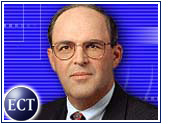According to a new study by investment firm U.S. Bancorp Piper Jaffray, the frenetic pace of online trading is slowing despite the fact that more people are participating.
Online brokerages added 1.1 million new accounts in the third quarter, bucking the cyclical slowdown that the trading business usually sees in that period. However, the overall number of trades on the Internet fell 7.8 percent from the second to the third quarter, the brokerage group said.
The study suggests that the slowdown is less an indication of flaws in the online trading model than a sign that online trading companies may be settling back into the pack of traditional trading firms after a meteoric rise in popularity over the past several quarters.
In the third quarter, the study notes, the online brokers “began to reflect the behavior of the major exchanges.” Trading volumes on the New York Stock Exchange and the NASDAQ both dropped 2 percent in the third quarter, showing that online trading is not immune to overall market trends.
Room for Optimism
Online trading still shows some promising signs, Piper Jaffray said. The 1.1 million new accounts added in the third quarter was an 11.5 percent increase from the second quarter, and online traders reported that their account holders have $648 billion (US$) in assets, up 6.6 percent.
“With 1.1 million new accounts added in the September quarter and an improved outlook for trading activity heading into the busiest season, we believe this quarter will prove to be a brief respite on the way to a continued growth trajectory,” Piper Jaffray analyst Stephen Franco said.
Although asset growth lagged behind account growth, Piper Jaffray said that the relationship will likely level out over time. “We believe assets levels will continue to grow as new investors become comfortable with the online medium,” the company said.
Schwab Leads Again
Charles Schwab & Co. again topped the list of online traders in terms of trades per day, assets and market share. The company far outpaced its competitors in trading volume, including both self-trades and broker assisted online trades, reporting nearly 118,000 per day compared to 76,000 by its nearest competitor, E*Trade.
Schwab topped Fidelity for total assets, with $263.6 million compared to $200 million, despite the fact that Fidelity has the most accounts with 3.06 million to Schwab’s 3 million.
However, the company’s market share, while still leading at 23.3 percent, dropped nearly 14 percent. Schwab, which had held nearly 28 percent of the market six months ago, was one of the many online traders to fall victim to the explosion of Cybercorp onto the trading scene.
Although it has only 1,000 account holders, Cybercorp reported more than 9,200 trades per day and its overall online trading volume increased by 67 percent, according to Piper Jaffray. “Cybercorp, which specifically targets day traders, was the only online broker surveyed to post trading volume gains during the quarter,” Piper Jaffray said. The company holds a 1.8 percent market share.
E*Trade showed the fruits of its aggressive advertising and marketing efforts, adding 310,000 new accounts in the quarter at an account acquisition cost of $198 each, Piper Jaffray said. E*Trade topped the new accounts category for the first time, beating out the usual leader, Schwab.
By adding so many new customers, E*Trade managed the lowest drop in market share of all the brokerages, losing only 0.3 percent, while the next smallest market share loss was 3.1 percent by National Discount Brokers.






































Social Media
See all Social Media